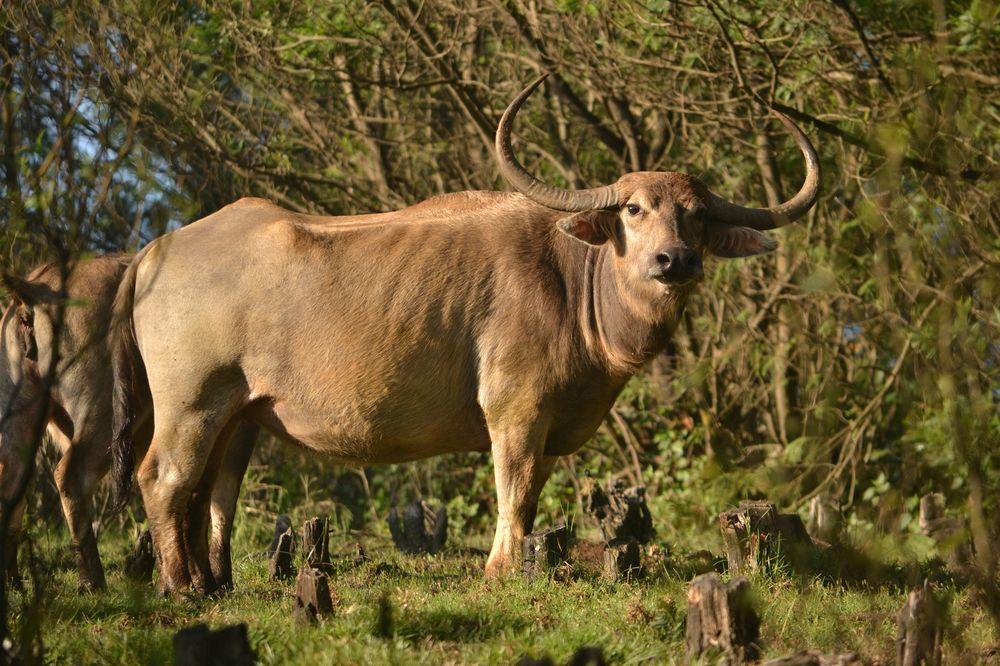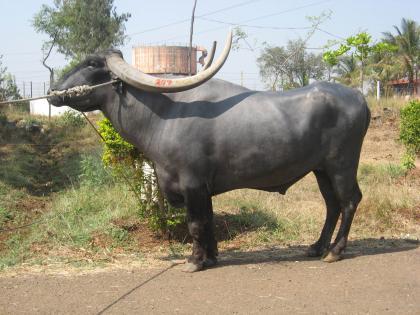Nili-Ravi Buffalo
The Nili-Ravi Buffalo is a large-size buffalo that are spread throughout a large area in Northern India especially Punjab), and is primarily a milk type of buffalo breed. However, the males are sometimes used for draught purposes, especially while preparing land for cultivation, and even as a good source of beef production.
Quick Information
| Also known as | Panch Kalyan |
| Physical Characteristics | Large, wedge-shaped body with a deep and low set frame; White markings are found on forelegs, hind legs, and white spots on forehead, muzzle; they are generally walled-eyed; the tail is thick at the base, gradually tapering towards the end extending below hocks with a white switch; the head is somewhat long bulging at the top and depressed between the eyes; the neck is long and thin; udders are well-shaped, while the teats are long and slightly squarish in shape; males (bulls) are larger |
| Horn | Small, tightly curled (less curled than the Murrah), circular in cross section |
| Body Color | Black, Brown |
| Uses | Milk production, dairy (primarily) |
| Popular Traits | Can yield high quality milk; extremely hardy and economical to rear |
| Lactation Duration | 300-305 days |
| Weight | Male: 728 kg; Female: 605 kg (adult averages) |
| Height (size) | Male: 142 cm; Female: 133 cm (adult averages) |
| Food/Diet | Roughages like barley and wheat straw, cornstalks and sugarcane residuals, concentrate mixtures; also graze on their own, if available |
| Country of Origin | India |
History and Distribution
In the past, the Nili and the Ravi were two different breeds of buffaloes. However, because of extensive crossbreeding, the two independent breeds merged into one single breed, and came to be known as the Nili-Ravi.
This breed is spread throughout a large area, and is found in almost all the provinces in Northern India. The major concentration, however, is in Amritsar, Gurdaspur and Ferozepur districts of the Indian state of Punjab. They are also spread in many places in Pakistan, including Lahore, Multan, Bohawalpur, Sheikhupura, Bahwalnagar, Faizabad, Okora, and Sahiwal districts.
Farming, Calving & Milk Production
This is a top milk yielding breed, with a very high rate of per day milk production comparable to only the Murrah Buffaloes. These animals are naturally mated. The calving interval is 443 days. The cows lactate for around 305 after a calf is born. They are kept together with the calves and are hand-milked twice a day. The lactation yield ranges from 1586 to 1929 kg, whereas the average is 1850 kg. The amount of fat in the milk is 6.8%.
Interesting Facts
- The name ‘Nili’ is said to have derived from the blue water of river Sutluj. In Hindi/Urdu, the word ‘Nili’ means blue.
- Minor populations are also found in Bangladesh, China, Philippines, and Sri Lanka.
- The other name ‘Panch Kalyan’, or ‘Panj Kalian’ [Female: ‘Panch Kalyani’] has been derived from the white markings on five different parts of the body – the forehead, face, muzzle, legs and tail, a trait which is expected, and said to be a lucky charm when present in a female Nili-Ravi. In Sanskrit and Pure Hindi, ‘Panch’ means ‘five’, while ‘Kalyan’ refers to ‘auspiciousness’.
- Presently, the population is around 6.5 million.











